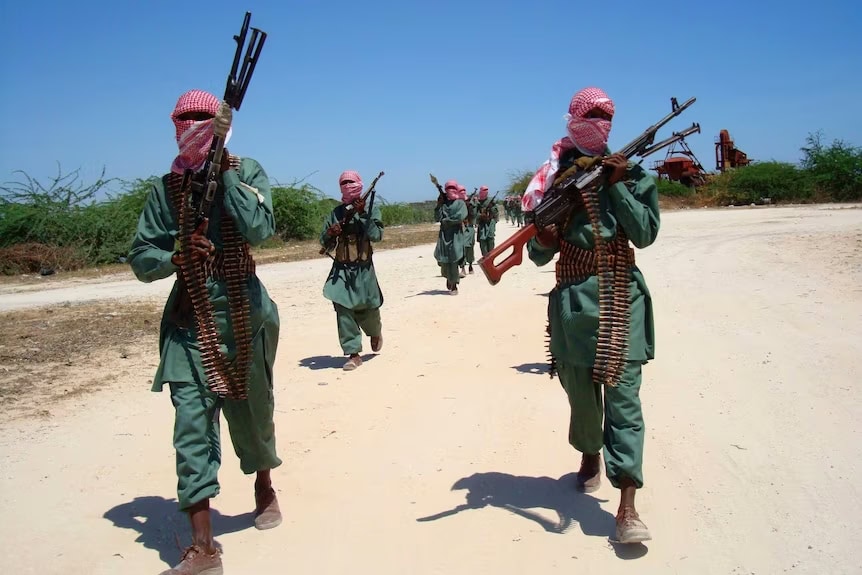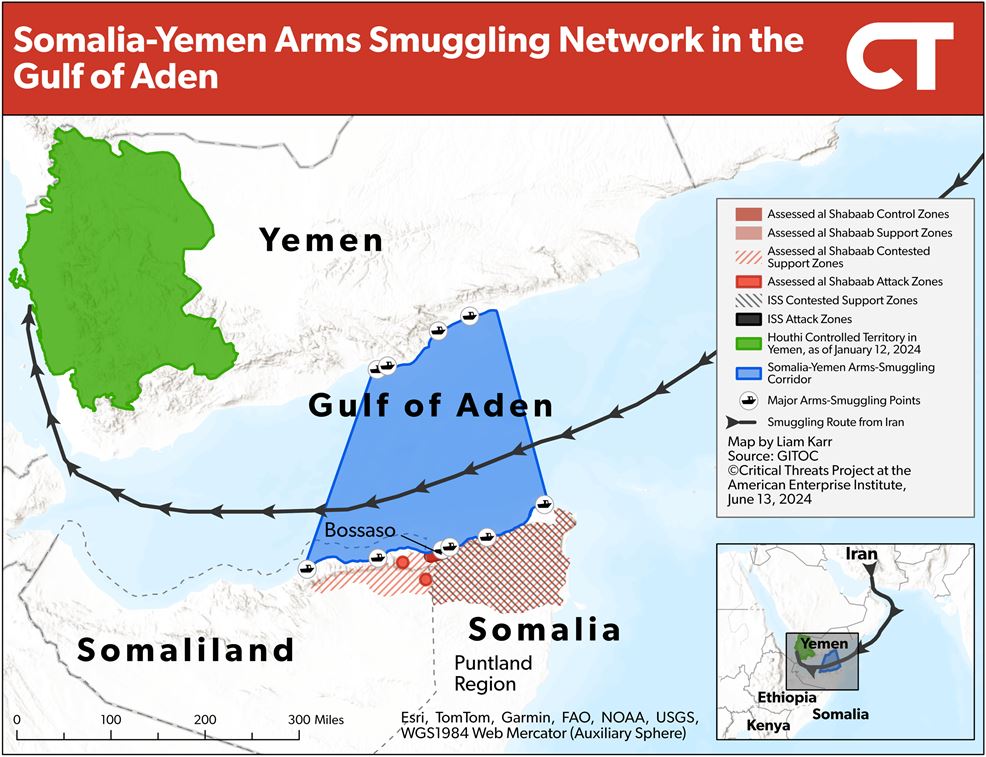
Reuters
Last updated on: 30-06-2024 at 4 PM Aden Time

It is difficult for the Houthis to take a decision on coordinating and cooperating with the Al-Shabaab without direct instructions from Iran. This is also the case with many other decisions taken by the group.
Ibrahim Ali* (South24)
A fortnight ago, the United States intelligence revealed that the Houthis are holding talks with Somali militant group ’Al-Shabaab‘ which is affiliated with the Al-Qaeda and providing them with weapons supplies. A CNN report quoted three US officials as saying that Washington is studying the links between the Al-Shabaab fighters and the Yemen-based Houthis. This development came as the Al-Qaeda’s branch in the east of Africa reversed the territory gains achieved by the Somali army over the past two years.
The American report talked about an emerging Houthi relationship with Al-Shabaab. The United States is worried that matters could get worse in the Red Sea and the Gulf of Aden. According to the “Critical Threats” Project, affiliated with the American Enterprise Institute, “the two groups have indirect connections through regional illicit arms networks that would likely facilitate indirect talks. Direct talks would indicate that the groups are interested in exchanging higher-grade systems not typically exchanged in the Gulf of Aden smuggling network, such as surface-to-air missiles and attack drones”.

Weapons smuggling network between Yemen and Somalia in the Gulf of Aden (The Critical Threats Project)
Fact or Exaggeration?
It is important to mention that the American accusations against the Houthis come amid an escalation in the operations targeting each other in land and sea. This also coincides with a media war after the Houthis levelled espionage accusations against detained employees at the US Embassy in Sanaa. This may raise doubts regarding the US intelligence report, especially since a few days later Washington imposed sanctions on three entities in China for involvement in the supply of weapons to the Houthis. Moreover, Washington has repeatedly accused Iran of providing the Houthis with weapons.
Nonetheless, reading the accusations according to this side or the attempt to arrive at results based on such evidence may not help in knowing the complete truth. This is especially related to the fact that cooperation between the two ideologically discordant parties (the Houthis and the Al-Qaeda) took place elsewhere as a result of some developments over the past years. This has made the occurrence of things that may otherwise be considered impossible very likely.
Local and Regional Developments
Therefore, it is important to view the US accusation in the light of many local, regional, and international developments. These include the appointment of Saif Al-Adel, who resides in Iran, as the Leader of Al-Qaeda after his predecessor Ayman Al-Zawahiri was killed in a US drone attack in Kabul in July 2022. This is in addition to the Houthi attacks on international navigation in the Red Sea and the cessation of the attacks between the Houthis and AQAP (Al Qaeda in the Arabian Peninsula – the Yemeni branch) since 2022.
However, some factors bring out the existence of a previous relationship between the Houthis and Al-Shabaab, though its nature isn’t clear. A report in 2020 by ’The Global Initiative against Transnational Organized Crime‘ (GITOC) said that some weapons delivered to the Al-Shabaab from the Yemen-Somalia network were basically Iranian shipments to the Houthis and that this was likely a result of arms dealers seeking profits. Investigations revealed that a Houthi official had direct links with a Somali arms smuggler who provided weapons to the ISIS branch in north Somalia.
The Iranian Role
Additionally, it would be difficult for the Houthis to take a decision on coordinating and cooperating with the Al-Shabaab without direct instructions from Iran. This has been the case with many other decisions taken by the group. It isn’t limited to taking such decisions but also related to the group’s potential success in making it into a reality, even its understanding with the AQAP. The Iranian role needs to be seen in its entirety in order to understand the moves of Tehran’s different arms in the region, foremost of whom are the Houthis. This is although the CNN report cited American officials as saying there is no direct evidence yet of Iran's involvement.
Another important fact to be kept in mind is that Iran has succeeded in fostering much rapprochement and cooperation between the Houthis and the AQAP. This began by conducting prisoner exchange deals in 2015. The cooperation reached a level beyond the cessation of mutual targeting operations. Ever since the AQAP halted operations against the Houthis, it has received drones to target the Southern armed forces in Abyan and Shabwa provinces in South Yemen. It is pertinent to mention that since it was founded in 2009, the AQAP hasn't used such a weapon against its opponents. Even surmising that the AQAP has developed such drones with their own efforts, it would be difficult to use it effectively without external technical support.
This means that the ideological differences, which make some rule out cooperation between the Houthis (Shia Muslims) and the Al-Shabaab (Sunni group), won’t be an obstacle to their cooperation. However, one can raise a question about what has made this possible. For this, one should keep in mind that Al-Qaeda Leader Ahmed Saif Al-Adel resides in Iran. He is the architect of the rapprochement between the Al-Qaeda branches and Iran’s proxies in the region. Over the 1990s, Iran supplied the Al-Qaeda with refuge, training, and funding.
It can be safely argued that Saif Al-Adel is the only explanation for the change in the nature of the relationship between the Al-Qaeda and Iran. This has been clear in Yemen. Although the AQAP made the Houthis their first and basic target of operations after 2015, this has changed later. The change has been clear in two important points, the first is the AQAP’s withdrawal from its last bastions in Al-Bayda governorate (controlled by the Houthis) in 2021. The second is the AQAP’s cessation of operations against the group for two years and focusing instead on the Southern Transitional Council (STC). According to British researcher in Al-Qaeda affairs, Elisabeth Kendall, the AQAP hasn’t carried out any operation against the Houthis since July 6, 2022.
If Saif Al-Adel has been able to create a rapprochement between the AQAP and Houthis, it isn’t unlikely that the same understanding has been established with the Al-Shabaab, which is Al-Qaeda’s branch in East Africa. Although this isn't evidence in itself, it is considered a strong proof that supports the American accusation against the Houthis. This especially came after the Houthis threatened to expand their operations to the Indian Ocean and turned the threat into reality by carrying out attacks against some cargo ships which allegedly have links with Israel.
Moreover, it is difficult to say that the Houthi’s own capabilities are behind them expanding their circle of operations beyond the Red Sea to the Mediterranean and Indian Ocean without coordinating with other groups such as the Al-Shabaab. A senior U.S. defense official said that “the Houthi militants in Yemen view this nascent collaboration with Al-Shabaab as a means “to be taken more seriously” as they try to pose a threat to American and British vessels outside of the Red Sea”.
Additionally, through their operations in the Red Sea, the Houthis have been able to present themselves as an initial pressure card against Israel. Many believe that the Gaza war has created much rapprochement between the Al-Qaeda and Iran and its wings in the region. This has even happened with the branches affiliated with the Muslim Brotherhood to which Hamas belongs. This can be noted through statements by some leaders of the Islah Party in Yemen, such as the recently-deceased prominent cleric Abdulmajeed Al-Zindani, Mohammed Al-Hazmi, Mabkhout Bin Aboud Al-Sharif, and others. This is in addition to the change in the policies adopted by some of their satellite channels, such as ’Al-Mahria‘ which broadcasts from Turkey.
Accordingly, it can be said that the ideological disharmony between the Sunni movement ’Al-Shabaab‘ and the Shiite group ’the Houthis‘ doesn’t constitute an obstacle for any rapprochement, cooperation, or coordination between them. The factors that may explain their quest for cooperation can be summarized as follows”:
1- Confronting a common enemy: Both Al-Shabaab and the Houthis view the United States as the main enemy. Historically, both groups have faced American military operations. Furthermore, mutual cooperation in exchanging weapons and experience would increase their ability to resist external interventions.
2- The desire to receive support: Both groups suffer from lack of resources and equipment. Therefore, cooperation with each other would allow them to access more weapons and funding.
3- Expanding their area of influence: The Houthis are likely seeking to expand their regional and maritime influence by supporting the Al-Shabaab. The latter group may be looking at cooperating with the Houthis as a good opportunity to strengthen their position in Somalia.
4- The ideological unity: Despite their ideological differences, both groups belong to one religion and share certain ideas and commonalities such as their solidarity with Gaza. This may constitute a common ground for cooperation.